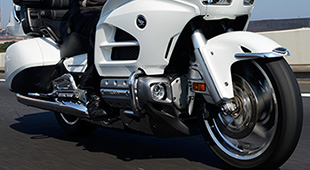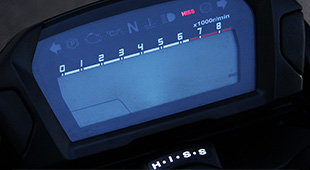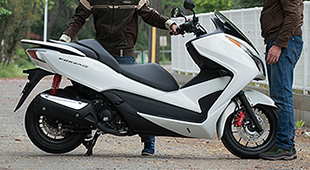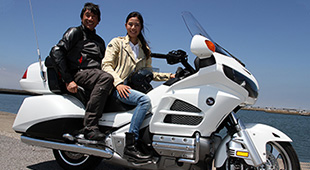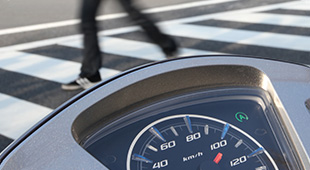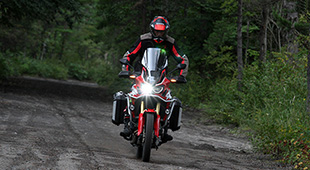Tech Views — Vol. 6 Rear Seats
Impressions (1/2)
Riders should be more concerned about their passenger seats.
The astonishing results of an investigation into the performance hidden there!
One day, while looking on a shelf in my room for a pair of goggles to use on a job, I stumbled upon a bag that contained a bunch of old photographs and film. I'd completely forgotten that I'd put that bag on the back of the shelf when I moved to my current home. The sight of those photos brought back a rush of memories! There I was, still in my early twenties. Vivid reminders of so many things.
Back in the day, I used to ride tandem quite a lot. And mostly those who sat on the rear seat were either friends or loves. I remember trying to improve my riding technique, trying to make my operation of the throttle, brake and gear shifts as smooth and comfortable as I possibly could, so nobody would tell me, "I'm never riding with you again!" While immersed in these old travel memories, a simple question ran through my mind: "Is passenger comfort on a motorcycle solely determined by the skill of the rider?" Or was this merely a preconceived notion I'd long held, based on my perspective as a rider?
Over the years, I've only had limited experience riding pillion perched on the rear seat. Despite that, from my own experience, I've often given advice to people that riding two-up in a way that makes girlfriends happy is a sure way to improve one's overall motorcycle riding skills.
I started wondering if rear seat comfort might instead depend more on a motorcycle's fundamental design and performance, and I made a note to myself that I should really reexamine the rear seat's seating comfort. Forgetting all about the goggles I was first looking for, I began thinking about how I could go about confirming this.
In order to test and confirm rear seat riding comfort, another rider would be necessary, as I'd often be the one riding pillion. So who would be the best choice? Several riders quickly came to mind and were soon dropped. Expert riders are certainly good at what they do, however I thought this test would require more of an expectant or anxious state-of-mind, similar to what I experienced when first riding pillion behind a friend during my high school days. This level of uncertainty would be more appropriate for accurately testing the rear seat and its seating comfort in ways that would be easier to understand. I also wanted the subjective opinions of another person without having to rely only on my own preconceived notions. So this other rider really had to be a woman! I thought that a woman's viewpoint, sharpened by the feelings of tension and unease brought on by trying to maneuver a motorcycle with a big man like me on the back, would make it possible to uncover the true sensations and level of comfort (or lack thereof) of pillion riding.
As a result, I asked Miss Risa Nishimura to take part in the test. Risa is not only a well-known model, but also a motorcycle rider who regularly rides her own liter bike. Risa told me that while she'd been photographed in many locations riding or sitting on back of a motorcycle, this would be her first experience actually riding with a large man like me sitting behind her. She said, "Honestly, I'm not sure I can do as well you may expect" and didn't hide her concern. That meant that she was the perfect fit for the job I had in mind.
The most important test points were as follows:
- Comfort of the front, back and sides of the seat
- Positioning of the steps relative to seat
- Positioning of the grab bar, or hand holds, etc. and how comfortable the grip feels
- How comfortable does the rider feel when someone climbs on back?
Based on these key points, I set out to experience the comfort of a range of rear seats. And one fine Monday morning, we conducted our tests
PCX
First, I climbed on the PCX's rear seat. This was my first experience getting on behind a woman rider who was already astride a bike or, in this case, scooter. The PCX's low seat and easy reach to the ground left Risa, who stands 168cm tall, with nothing lacking in the way of confidence sitting on and holding up the . However, when I, at 180cm tall and weighing 85kg, swung my leg over the rear seat, which sits a bit higher than the rider's seat, I first worried that my extra weight might topple over the scooter. However, Risa said that she wasn't particularly bothered when I got on. My immediate impression was that the PCX not only offers an easy reach to the ground, but also excellent balance in that situation, indicating that the engineers designed it for a solid foot plant, which would be an important factor for commuters, as well as added peace-of-mind when a rider sits on the seat and places his or her feet on the ground. If the bike were to lurch here, then the rider might get overly nervous, even on the move.
We started our ride on a busy street. Soon after turning at the first intersection, we stopped at a red light. I asked Risa if she was okay, and she replied, "This is easier than I thought it would be, with fewer distractions."
That sounded good, so I concentrated on evaluating the ride on the rear seat.
The instant I sat down, I discovered the seat's surface area and fit to be good. The fold-out passenger steps are shaped to integrate nicely with the scooter's stylish good looks, and flip out easily for passenger use. The steps are positioned for a comfortable seating position, and contribute greatly to the PCX's overall sense of stability. However, while waiting for the light to change, I found I had to take care not to let the toes of my boots bump into the rider's (Risa's) lower leg. When on the move, there was no contact at all.
Under acceleration, I felt that the seat offered an appropriate mix of firmness and shock absorption to securely support my weight. Further, the space at the front and rear seemed well separated to keep me from interfering with Risa's riding. There was also ample seating area forward and back to allow me to move my bottom around and not get locked into one, eventually uncomfortable position.
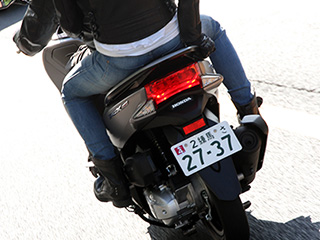
The stylish, boomerang-shaped tail section surrounding the back of the seat also doubles as the grab rail, and its attractive form lends a sporty touch to the PCX's overall body design. Also impressive is the detailed consideration given to the design of often overlooked parts, including the ergonomic shaping of this tail section to give it a comfortable hand hold that's easy to wrap one's fingers around at virtually any position without any limitations. That played a big part in reducing fatigue by allowing me to sit in a relaxed posture, particularly when combined with the spacious rear seating area, which offered ample room front and rear to shift my weight during acceleration and braking.
When we came to a bumpy stone-paved road, I found the PCX offered a much more comfortable ride than I first expected, including both its suspension and engine response. Being able to comfortably ride tandem through town is an important feature in a commuter. The ride was remarkably smooth, without feeling any unpleasant engine vibration or rough bumps in the road through my bottom. In fact, it was so smooth that I felt I could relax and ride forever in these conditions. The view from the rear seat wasn't bad, either. I was again reminded that the rear seat's comfort depends on a combination of good positioning, sufficient seating space, etc., which all come together to determine a bike's overall strengths.

Risa noted, "I was surprised to find that the PCX was quite a bit easier to ride than I first thought it would be." As you know, she was riding a mid-sized scooter with a big 85kg man sitting behind her. She continued, "My riding position while carrying a passenger was remarkably relaxed. Since the PCX is only a 150cc-class scooter, I prepared myself to feel cramped with a passenger behind me, but its surprising spaciousness made it easy to maneuver. I also expected that riding double on this class of scooter would be slow and difficult, but the engine had enough power available that I felt that even two-up touring on it might be possible. Creating a positive mood is one of the most important factors of bike performance.
I've ridden pillion on other makes of scooter in the same class before. One time, it was a two-up ride with two sizeable men on the bike, and when I climbed onto the rear seat, the front of the scooter became noticeably lighter and appeared to be somewhat unstable. Because of this, I still remember straining my hands to hold onto the skinny grab bar, and gripped it so hard that it hurt my fingers.
And although the size of the seat itself was not especially small, it seemed to transmit engine vibration and rear suspension movement more directly to the rear saddle than to the rider's seat. If issues like this are not made clear, it makes me feel uneasy. Honestly, I didn't feel like riding double again after that experience.
Even 125cc-class models have such large differences between people wanting to ride them and not wanting them at all. Is this only due to differences in cost? No, differences in manufacturer's consideration play a big part, a factor which became instantly clear this day.
Next Up: the CB250
This bike is the naked version of the CBR250R, and its wedge-like shape reveals impressive sports bike-like styling. Its rear seat is also slightly taller than the rider's seat.
Seeing Risa straddling this bike from the side presented a very stylish picture. Initially, I worried that it might be a bit hard for her legs to hold up the CB when a bigger and heavier man like me climbed onto its rear seat. However, Lisa was hardly even phased by me throwing a leg over and settling down on the seat.
The shape of the rider's portion of the seat enables an easy and secure reach to the ground, which certainly plays an important role in stability at stop. Its form tapers outward within comfortable range of most riders' legs, and no body parts bulge out to get in the way of their direct extension to the ground. The handlebars are also ideally sized and positioned to offer excellent support when stopped, further enhancing the CB's sense of stability.

Riders ranging from beginners to those with more expert skills, regardless of sex or physique, choose to ride motorcycles, so it's important that all the fundamental components be well made.
The suspension sank as I climbed aboard the rear seat, but Risa noted that she only needed to exert a bit of strength in one of her legs, and hardly noticed that somebody had gotten on the bike.
In fact, when I settled down on the rear seat, I found it to be a comfortable fit, and easy to stay balanced. The relative layout of the seat and steps felt good, as well.
Risa was able to start out on the CB smoothly and expertly. Although the rear seat pad is not particularly big, it never gave the impression that it was uncomfortably small either. Designed to provide good support for most bottoms, the positioning of the rear pegs made it easy to use my feet to coordinate my movements with those of the bike and rider, enhancing my sense of security.
The size and shape of the grab bar also offered a comfortable grip, and it seemed relatively free from the annoying vibration normally associated with single-cylinder engines at speed. The CB's chassis is robustly constructed, and seems impervious to bumps in the road surface, leaving me with the impression that I could tolerate a long day's outing seated right where I was.
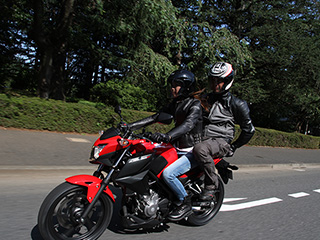
My body shifted back and forth as the gears were changed or brakes were applied, but it was easy to keep my balance by merely holding on lightly to the two integrated side grab rails and allowing the upper part of my body to sway back and forth. It felt fine to simply wrap my hands around the grab rails and enjoy the ride behind Risa. This grip helped prevent any exaggerated body movement that might interfere with Risa's otherwise smooth and careful control. It brought to light another important design criteria in that the passenger's environment needs to be to adjusted to allow the rider to concentrate on riding operations without being distracted by the passenger. Tandem riding is much safer and more enjoyable when both rider and passenger are comfortable.
I also found I was able to move around on the seat freely. Employing the latest in tail-up styling, the CB250F's designers seem to have taken great care in the design of the rear seat. Risa observed, "This CB250F is really easy to control, even riding double. At first I thought that its small 250cc engine might not have enough power for riding double, but that wasn't the case at all. The CB makes quite a good city commuter. Also, when we switched riding duties and it was my turn to sit on the rear seat, my first impression was that it was quite high, since the rear seat is positioned higher than the rider's seat. However, once we started out, I soon found I could easily support my body, so it wasn't scary in the least. Instead, I was able to enjoy the sensation of riding together almost as one with the rider."
Although our height and weight differ greatly, what Risa felt was nearly the same as my own experience. It was great to be able to hop on the rear seat and feel such a sense of security at the start of the ride that we could instantly share the pleasures of riding together.
- Top
- Impressions
- User Reviews

